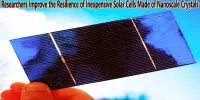A major advancement has been made in the creation of effective and sustainable electronic devices by a group of researchers from the Instituto de Carboquímica of the Spanish National Research Council (CSIC). They have discovered a unique way to combine two remarkable nanomaterials, resulting in a new hybrid product that can convert light into energy and vice versa more quickly than traditional materials.
The research is published in the journal Chemistry of Materials.
Ingeniously combined with a two-dimensional graphene derivative dubbed graphene oxide, this novel material is made of polythiophene, a one-dimensional conductive polymer. The special qualities displayed by this hybrid material hold great potential for enhancing the effectiveness of optoelectronic devices, including solar panels and screens for smart gadgets, among others.
Dr. Wolfgang Maser, the lead researcher on the project, explains, “Through our synthesis strategy, the polymer adopts a particular structure as water-dispersible nanoparticles, which favors an intimate contact with the graphene oxide sheets.” This contact then causes the polymer’s electrical behavior to change, greatly enhancing its electrical efficiency.
Dr. Ana Benito, co-lead researcher of the project, and leading alongside Dr. Maser of the Carbon Nanostructures and Nanotechnology group (G-CNN), says, “We were particularly intrigued by the advantageous optical, electric and electrochromic properties of polythiophene. While it generated electricity upon illumination, and emitted light when provided with electricity, its response was slow.”
“Having extensively studied graphene oxide a nanomaterial derived from graphene that has unique properties, is aqueous dispersible, and easy to produce the team hypothesized that combining the two materials would overcome the inherent electronic limitations of the polymer,” points out Dr. Maser.
“Our original concept was to modify the polythiophene, turning it into small nanospheres called nanoparticles, which could be easily combined with graphene oxide. Moreover, this methodology allowed us to work in aqueous dispersions, something extremely challenging with this type of polymers,” emphasizes Dr. Benito.
“Initially, we did not observe any changes in the electronic properties of the material. However, when we analyzed it in depth, we found that the new materials facilitated unusual rapid electron transport phenomena, so fast that we initially were not able to track it with the standard techniques.”
Collaborating with researchers from the Universities of Murcia, Cartagena and Zaragoza was key to confirm the relevance of their findings.
Our original concept was to modify the polythiophene, turning it into small nanospheres called nanoparticles, which could be easily combined with graphene oxide. Moreover, this methodology allowed us to work in aqueous dispersions, something extremely challenging with this type of polymers.
Dr. Ana Benito
A technological revolution
This ground-breaking finding has important ramifications for a range of technical applications, such as the creation of extremely effective electronic paper, portable electronic devices, and flexible, intelligent screens.
Eduardo Colom, the lead author of the article who investigates the hybrid materials in his Ph.D. thesis, explains, “Devices built with this novel material would exhibit superior efficiency, reduced weight, enhanced flexibility, and greater sustainability, all thanks to the use of environmentally friendly materials with outstanding electrical properties.”
Additionally, this development may increase the effectiveness of organic solar cells by more effectively and economically catching more solar radiation.
The authors further point out, “We may be able to make more energetically efficient electronic devices that consume less power while providing faster responses. These findings push us toward a future based on a more advanced and sustainable technology.”
A commitment to sustainability
By using water as the solvent instead of the hazardous chemicals that are typically used in existing techniques, the synthesis of this new hybrid material offers a big step towards sustainability. This has the ability to lessen the negative environmental effects of producing electronic products.
Additionally, the method of synthesis used might be applied to other conductive polymers, having significant consequences for technological applications. This discovery marks a significant step forward in the development of novel, environmentally friendly architectures for high-performance optoelectronic devices.
The G-CNN group’s research team has recently concentrated on developing extremely useful and sustainable nanomaterials. These adaptable nanoparticles are useful in a variety of processes, including the production of clean energies like green hydrogen, catalysis, energy storage, or even the preservation of cultural heritage, the development of (bio)sensors, and the treatment of disease.















